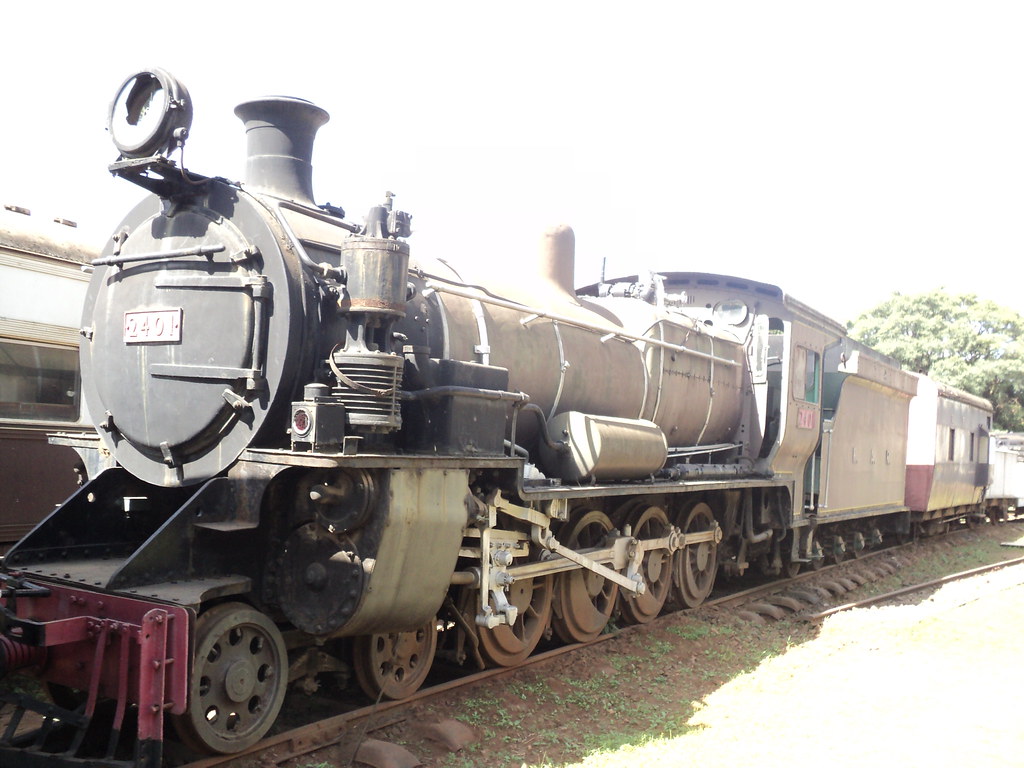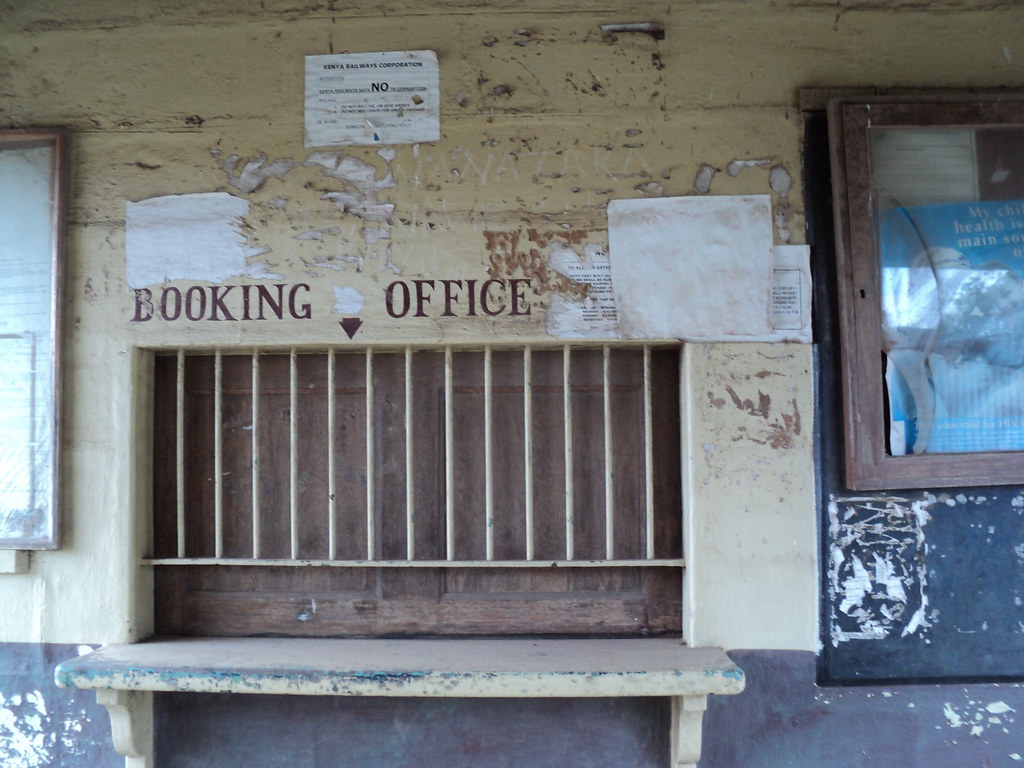One of the most ambitious projects on the African continent was the construction of the (Kenya) Uganda Railway Line. A British imperial project, it was later dubbed the Lunatic Line. Passing through 5 different physical regions comprising a variety of vegetative and climatic zones the line stretches from the coastal lowlands to the vast plateau, followed by the highlands, is interrupted by the Rift Valley and completes the Kenya side at the Lake Victoria Basin. 2,498 workers died during its construction, falling victim to illness, native attacks and the famous Man Eaters of Tsavo. The rail company set up its headquarters at a cool area that bordered the plains and the highlands; the settlement grew and is today Nairobi, the capital city of Kenya. The line finally reached Port Florence (Kisumu) in 1901. Initially estimated at 3 million in 1894, by the time the books were closed in 1902 the final cost was £5 million.
The Kenya-Uganda railway line created a country by opening the interior to the rest of the world. It allowed for movement of machinery; prior to the railway line transport was by ox-drawn cart. Years later settler farmers were to use it to export their produce via the coast. Several towns developed along the railway line – some, like Nakuru, have now grown into large urban centres. The rail became popular for both freight and passenger travel.
Unfortunately, the 80s and 90s saw the deterioration of the railway line marked by little investment and poor operations. A number of serious accidents in the early 90s diverted passenger travel towards the faster bus travel. Limitations in freight load also led to increased use of trailers for freight transport. Today, it takes 4 days to transport cargo from the Port of Mombasa to Kampala in Uganda by rail (down from 12 after restructuring) and almost the same by road. However the amount of cargo is limited by rail capacity: maximum load (known as standard) and number of locomotives available.
Rail in Kenya is primarily administered by two bodies that take care of rail transport, Kenya Railways Corporation(KRC)which is the national regulator and Rift Valley Railways (RVR), the operator of the current line. This system is understood to create openings for other operators when new lines are constructed. In rail terms it is known as Vertical Separation. There are a few exceptions, like the Syokimau line, where KRC is both regulator and operator. A study on separation on European Rails stated that the countries with the greatest improvements in efficiency are those that have restructured their networks both vertically and horizontally. The analysis of the determinants of efficiency also shows that both processes of vertical and horizontal separation have positive effects on efficiency in railway systems, with a greater impact stemming from horizontal separation. In contrast, no significant changes in efficiency and productivity levels are observed in countries where the industry has only been reformed at a horizontal level, and vertical separation has not subsequently been introduced at an institutional level.
From metro rail and light rail for passengers to diesel locomotives for movement of freight, rail transit remains a very popular mode of travel all over the world. Passenger travel was popular until the mid 90s but is now limited to commuter trains within Nairobi and its environs. There exists a Nairobi Commuter Rail Service development as part of Nairobi Metropolitan Transport Master Plan. As is the case the world over, passenger lines are not profitable ventures and are therefore subsidized by freight or by governments E.g. The Nairobi – Syokimau Commuter line is subsidized Kenya Railways Corporation.
In general, Rail travel and Railways have high barriers to entry with massive investments required towards construction of infrastructure and purchase of rolling stock. According to experts at KRC, the minimum requirements for an investor in the rail business would be 100 wagons and 5 locomotives . 1 passenger wagon costs approximately 1.3 million Euros while 1 freight wagon goes for 65-120,000 Euros and 1 locomotive is about 5 million USD. This makes it very expensive for players to come into the industry.
Rail transit is best for long haul and bulk transit. Kenyas current railway infrastructure has a freight capacity of 5 million tons per year and thus gets a lot of competition from road. Ultimately the limited freight capacity has necessitated the construction of a supplementary rail line in the form of the current Standard Gauge Railway Project. The Standard gauge offers potential for higher speeds for both freight and passenger due to the increased stability offered by the wider footprint.
There has been a lot of discussion about the Standard Gauge line and its necessity and/or viability. Basic information about standard gauge is that the distance between rails is 1435 mm. In general, the narrower the gauge the more the restrictions while the broader the gauge the more the capacity. To date, Kenya has been using a metre gauge, which is 1000mm between rails. Metre Gauge allows 47 Kg load per metre of rail while Standard Gauge allows 60 Kg load per metre of rail.
Kenyas railway network experienced serious decline up to 2006 with few or no decisions on the future of rail transit being made. Stock and infrastructure deteriorated. Today the country has a railway network of up to 2200 Km with only 1080 Km operational. Lines like Voi -Taveta and Thika – Nanyuki are rarely, if ever, used any more.
The last few years have seen attempted rehabilitation of the metre gauge rail that is expected to supplement the new standard gauge railway line when it is complete. This will enable faster and more effective movement of freight from the Port of Mombasa to the interior.
Between 2006 and 2009, known by some as the “RVR 1 Period, there was a consortium between South African investors Sheltam Rail Corporation and other minor investors. However, reduced freight and increased losses gave way to a new consortium in August 2010. Financing agreement reached in September 2011 and on December 29, 2011 provided necessary finance. The period August 2010 to September 2011 witnessed an increase in investment from $40 million to $250 million .
Recent developments have seen transit time between Mombasa and Nairobi reduce by 6 hours and October 2013 saw the relaunch of the Ugandas Tororo-Gulu-Packwach cargo line. The firm also purchased an automated track maintenance unit at KES 200 million that works as a balance regulator and compactor rather than having the work manually done (thus increased accuracy).
As at last year, Kenya was studying the necessity of having an independent regulator with the goal of encouraging investors in the industry. South Africa has an independent regulator who looks at aspects such as running of the lines and safety.
At the moment, KRC is managing the concession and facilitating the development of national railways and of commuter rail networks in major cities. They inspect the main line about 2 times a year and have a rolling stock of about 20 locomotives, 16 for Kenya and 4 for Uganda. RVR maintains and operates infrastructure and rolling stock, investing about 5 million USD per annumn, and have had to re-build infrastructure that was abandoned for several years.
RVR is attempting to extend loops to as to increase the length of the trains, currently one train carries 25 wagons (1 locomotive), whereas it is known of one line having 400 wagons in South Africa with 8 locomotives powering them.
South Africa uses Cape Gauge (1 yard) and is able to haul 6 times more than the rest of Africa. It has the advantage of a broader gauge but their bigger strength is operations. Japan uses Narrow Gauge for terrain and Standard Gauge for passenger speed trains.
Investment and skilled operations are viewed as critical. It is estimated that 1 train can take up to 50 trucks off the road. With heavy industrial goods, trains can also be taken right into factories (thus solving challenges of last mile).
A controversial factor, however, is the fact that Kenya’s rail operator pays road levies of up to 1 billion KES per year- through fuel purchase – essentially sponsoring a competitor.
In 2013, the World Bank released a Paper entitled “The Economics of Rail Gauge in the East Africa Community. The paper provided four alternatives for upgrading the current railway network:
- Rehabilitate the current network to the original standard and gauge, 80 Kph, 5.5. Million tons per year (most cost effective at 0.18m UD per KM).
- Upgrade the current gauge to a higher standard using the same gauge. 25 tonnes per axles, 120 kph, 60 million tons per year, 0.49 m USD per km of track (more expensive but cost effective as it re-uses materials and existing right of way).
- Upgrade the current network to a higher standard on a different gauge e.g. standard gauge. 25 tonnes per axles, 130 kph, 60 million tons per year, 1.50 m USD per km of track.
- Construct a new right of way. 25 tonnes per axles, 130 kph, 60 million tons per year, 3.25 m USD per km of track (most expensive due to land acquisition and structures).
East African Freight revenue in 2009 was in the range of USD 65 million. Based on current assumptions, the World Bank estimates that by 2030 there will be up to 14.4 million tonnes transported per year. From these estimates, it recommended upgrading of the current gauge to a higher standard.
The government of Kenya, however, opted for the fourth option, to construct a new right of way.
Critics of the Government Decision, claim that transportation of cargo at 80KPH cargo can be achieved with the current railway gauge. Pointing out how Alternative 2 would enable us to transport up to 60 million tons per year, they mention how Brazil moves 100 million tonnes on a metre gauge, South Africa 200 million tones on Cape Gauge.
They also state that our priority is not passenger (which is subsidized by cargo), there is little benefit in fast freight trains as freight has low value for time.
There have also been claims of disparities in the cost of the Standard Gauge and fears of regional incompatibility should neighboring countries (Uganda and Rwanda) not opt for standard gauge. The biggest fear, however, is financing as the new right of way is being constructed on loans that will have to be paid for generations to come.
There have been a number of misconceptions in the public such as that Standard Gauge is a new concept. ( Standard Gauge started in the 19th century and was used in 1864 in the US) and that Metre Gauge is not used any more. In Brazil and Queensland, heavy duty metre gauge tracks are able to carry similar loads to Standard Gauge tracks (strong rails and precise cross bars allow an axle weight of 25 tons). Others also believe that the SGR is a fast speed electrical train. However, the engines are diesel powered. As a matter of fact, Kenya’s National Electricity production is less than what is required to serve an electric train (17000MW vs. 1600MW national production).
Many have also asked why go standard when Rails of the same gauge (metre) are used in neighboring countries, for better connectivity. Neighbouring Countries, however, have also tabled proposals to have a Standard Gauge Rail including Uganda and Rwanda.
Is there economic rationale for the SGR? What are our views of the World Bank Report vis-a-vis the Government Decision? With poor operations being the major hurdle in East African Rail, do you see the new SGR falling into the same dilemma?





interesting article about the state of our railways well researched am a locomotive fun
Great piece. There is a great quote in the Nairobi Museum of how important the rail is to Kenya. It goes something like, “It is not uncommon for a country to create a railway, but it is uncommon for a rail to create a country”. I think Rail is the way to go in Kenya.
Thats good. Well researched content. Keep up.
Very well researched. Kenya and East Africa cannot afford building standard gauge on loan. Given that meter gauge can perform same function. The resources could have been used in developing Kenya’s agriculture instead.
The sad part is that there were several viable alternatives which were ignored. Anyway, now that it is here – we use it.
A very in-depth analysis of the SGR. Gives a whole new perspective to the issue. I still think Kenyans will appreciate it with time.
I hope we can maintain it. We didn’t maintain the previous infrastructure – we are just lucky they were extremely well built wagons and locomotives.